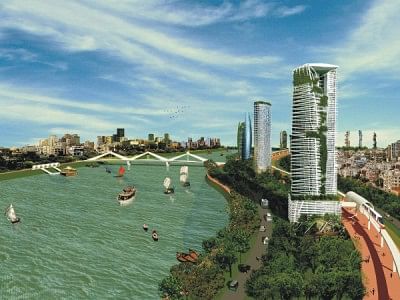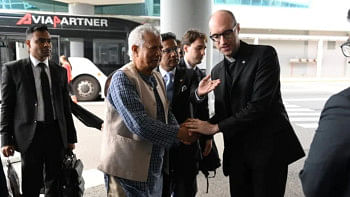A new Dhaka is possible

ONCE upon a time, Dhaka was a very fine city. There were shaded and leafy streets, boats plied in the heart of the city, the air was cleaner, there was a sense of community among its citizens, people promenaded on the banks of the river, children played on open fields, until all those were usurped by the fangs of merciless urbanisation.
Dhaka is now marked more by a frenzied economic engine and a lopsided sense of its future. What is touted as "growth" in Dhaka is actually the pillaging of the city in the name of planning and development.
The end result is the same as elsewhere where the city is left to such pillage: curse of pollution, widening social inequality, increasing break-down of community, wretched transport and road system, blatant occupation of land and waterways, and ravaging of public spaces. No wonder Dhaka has acquired the dubious title of being one of the most "unliveable cities" of the world.
Many modern cities have encountered pains of ruthless urbanisation, where development was not orchestrated by determined planning but by a combination of laissez-faire, ad-hoc, and pell-mell procedures. The city, in such a condition, practically becomes a hostage "in the hands of the mobs," as one writer was to comment on a major American city in the 19th century.
The British writer Francis Trollope wrote about another American city from the same time: "Every bee in the hive is actively employed in the search for honey … neither art, science, learning, nor pleasure can seduce them from their pursuit."
The city of possibilities slowly becomes a curse, a wretched place, when it succumbs to the relentless pursuit of monetary profits unless a combination of careful planning and civic commitment can turn that around. Dhaka is far from turning around; we are very much in the bowels of a disorder and don't quite know, besides some false promises and fake grandiosities, where to go with our city.
In the epoch of digital revolution and increased GDP, climate change and energy conservation, where is the vision for the city and its regions? Where is the place of cities in our national vision in the 21st century?
We seem to be hop-stepping from one problem solving gesture to another: it is transport one day and housing another day, and then it is cleaning the river one moment and land-grabbers another moment. While all those enterprises are crucial, and we feel a little assured that some of those concerns are now part of a broader consciousness, the city is basically seen as a series of problems, and we are merely busy fixing them. We are basically proceeding without an understanding of the city as a civic, living experience.
A good city is a civic organism. If piling buildings after buildings next to each other, on top of one another, does not make a city, what does? The term "city" itself derives from civitas, a Latin word with a cluster of meanings: citizen, civic, and civilisation. As the city draws people from various ethnic, racial, and social categories into one space, it becomes a place defined by differences and complexities.
The most critical need for a city is a civilised means of addressing and sorting out these differences. The city ought to be a place where one may find one's personal and spiritual fulfillment in the company of others, uncoerced and in the light of human dignity.
The ultimate expression of a well-formed civic place is the cosmopolis that becomes, in the view of the French philosopher Jacques Derrida, "a city of refuge," a place that guarantees anyone the right to residence and hospitality, and the opportunity for work, recreating and creative activity in a "durable network of fulfillment."
For the full version of this article please read this month's Forum, available free with The Daily Star on March 8.
Kazi Khaleed Ashraf is an urbanist, architect, and writer, and teaches at the University of Hawaii. Ashraf's writings on the urban future of Dhaka, including sections of this article, appeared in The Daily Star and FORUM since 1996, which have occasionally been co-authored with architect Saif Ul Haque.

 For all latest news, follow The Daily Star's Google News channel.
For all latest news, follow The Daily Star's Google News channel. 



Comments